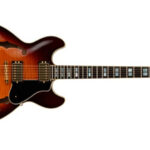The Gsus4 Guitar Chord, a member of the suspended chord family, offers a unique and evocative sound that can enrich your guitar playing. This chord, built with the notes G, C, and D, utilizes the 1st, 4th, and 5th intervals – Root, Perfect Fourth, and Perfect Fifth – creating a sound that is neither strictly major nor minor, but beautifully ambiguous.
If you’re interested in delving deeper into the theory behind chord construction and intervals, our comprehensive guitar music theory tutorial provides a foundational understanding. For guitarists looking to visualize and master intervals across the fretboard, our dedicated fretboard intervals tutorial offers invaluable insights. And to broaden your understanding of suspended chords and their application, explore our detailed guide on suspended guitar chords.
This tutorial will guide you through playing the Gsus4 chord in various positions on the guitar neck. We’ll provide clear chord diagrams and fretboard patterns, highlighting the notes that constitute this versatile chord. For a complete overview of guitar chords, including diverse types and voicings, our ultimate guitar chords of all types tutorial is an excellent resource.
Ready to explore the sonic possibilities of the Gsus4 chord? Let’s begin!
Understanding the Gsus4 Chord: Notes and Formula
The Gsus4 chord is defined by its specific notes and interval structure.
Notes in the Gsus4 chord: G, C, D
Chord Formula: 1, 4, 5 (Root, Perfect Fourth, Perfect Fifth)
This formula differentiates the Gsus4 from a G major chord (G, B, D) by replacing the major third (B) with a perfect fourth (C). This substitution creates the “suspended” quality, often described as open, airy, or unresolved, lending a distinctive flavor to your music.
Exploring Gsus4 Chord Positions on the Guitar
The Gsus4 chord can be played in multiple positions across the guitar fretboard, offering different voicings and ease of play. Here are some common and useful positions:
Position 1: Open Gsus4 Chord
The open position Gsus4 is often the first shape guitarists learn due to its simplicity and accessibility.
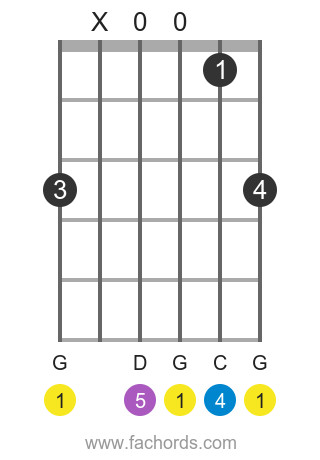 Diagram of the open position Gsus4 guitar chord
Diagram of the open position Gsus4 guitar chord
This position is played as follows (from thickest to thinnest string):
- 6th string (E): Not played (or muted)
- 5th string (A): 3rd fret (G)
- 4th string (D): Open (D)
- 3rd string (G): Open (G)
- 2nd string (B): 1st fret (C)
- 1st string (E): Open (E) – While technically an E note, in this voicing, the emphasis is on the G, C, and D notes defining the Gsus4 chord.
This open voicing is bright and resonant, ideal for strumming and folk-style guitar playing.
Position 2: Barre Chord Gsus4 (Movable Shape)
This barre chord shape is movable, meaning you can play a sus4 chord with any root by shifting this shape up and down the neck. This particular diagram shows it rooted at the 5th fret, making it an A sus4 chord shape, but visualized in the context of Gsus4 positions for progression. To play Gsus4, you would move this shape down to the 3rd fret (root on the 6th string, 3rd fret).
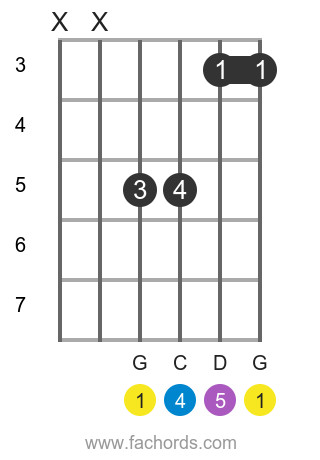 Diagram of a barre chord Gsus4 guitar chord shape, position 4 in original article
Diagram of a barre chord Gsus4 guitar chord shape, position 4 in original article
This barre chord shape, when played as Gsus4 (root on the 3rd fret of the 6th string), is a versatile voicing suitable for rock, pop, and more contemporary styles. Barre chords provide a fuller, more powerful sound.
Position 3 & 4: Further Barre Chord Variations
Positions 3 and 4 from the original article offer additional barre chord shapes for Gsus4, providing further sonic options and fingerboard navigation practice. These shapes, while also movable, may be less commonly used than the open position and the barre shape described in position 2, but are valuable for expanding your chord vocabulary and fretboard knowledge.
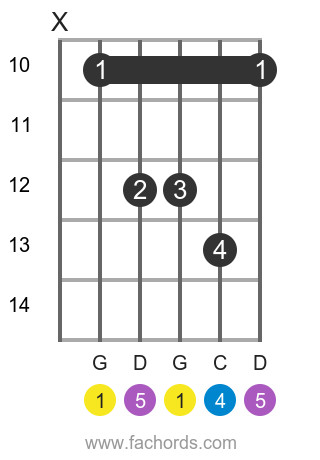 Diagram of a barre chord Gsus4 guitar chord shape, position 3 in original article
Diagram of a barre chord Gsus4 guitar chord shape, position 3 in original article
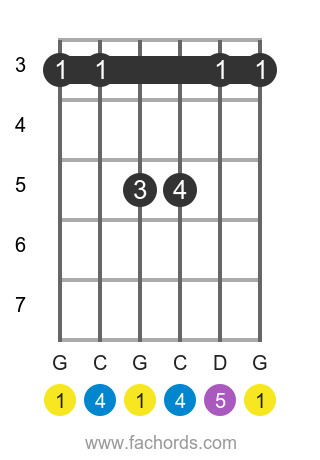 Diagram of a barre chord Gsus4 guitar chord shape, position 2 in original article
Diagram of a barre chord Gsus4 guitar chord shape, position 2 in original article
Experiment with all these positions to discover which voicings you prefer and which are most suitable for different musical contexts. Remember to practice transitioning between these Gsus4 shapes and other chords to improve your chord changes and overall playing fluidity.
The Musicality of the Gsus4 Chord
The Gsus4 chord, and suspended chords in general, are often used to create tension and release in music. Because the 4th interval creates a feeling of suspension or anticipation, Gsus4 chords frequently resolve to a G major or G minor chord. This resolution provides a satisfying harmonic movement.
Common Musical Applications:
- Transitions: Gsus4 can be used as a transitional chord between other chords, creating a smoother and more interesting progression.
- Intros and Outros: Its open and airy quality makes it effective for intros and outros, establishing a mood or providing a gentle conclusion.
- Folk and Pop Music: Sus4 chords are widely used in folk and pop music to add harmonic interest without sounding overly complex.
- Building Tension: In genres like rock and ballads, Gsus4 can build tension before resolving to a G major chord, adding emotional depth.
Explore incorporating the Gsus4 chord into your own playing and songwriting. Experiment with different strumming patterns, fingerpicking styles, and chord progressions to discover the unique character it brings to your music.
Expand Your Chord Knowledge
Mastering the Gsus4 chord is a valuable step in your guitar journey. To further enhance your chord vocabulary and theoretical understanding, we encourage you to explore our extensive guitar chord library, where you’ll find chords of every type and in every key. For convenient access offline, you can also download our free guitar chords chart PDF.
Continue practicing and experimenting, and you’ll find the Gsus4 chord becoming a valuable and expressive tool in your guitar playing.

